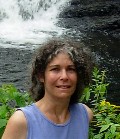Reading Our Region
Essays from a Regional Writer
 Susan Charkes enjoys hearing and telling stories, especially those involving the environment, farming, and sustainability in our region. Discover her poetic view of the outdoors and be inspired to visit the places she describes. Learn more about Susan, her writing, and even hear her podcasts at www.susancharkes.com.
Susan Charkes enjoys hearing and telling stories, especially those involving the environment, farming, and sustainability in our region. Discover her poetic view of the outdoors and be inspired to visit the places she describes. Learn more about Susan, her writing, and even hear her podcasts at www.susancharkes.com.
Sample these selected writings:
| Featured Items: |
Giving Pond Recreation Area
by Susan Charkes
Other than the clop-clop of your sandals on sun-baked dirt, the only sounds are the cheep-cheep of birds foraging in the roadside shrubs and the buzz-buzz of bees short-hopping between wildflowers. Now, around a bend, the summer sun glints off water. The road descends; it doesn’t so much end, as slip beneath the surface. Push your boat down the gentle slope, grab your paddles, and shove off.
A great blue heron glides overhead like a kite, headed for the opposite shore, and you follow on an invisible tether. The current pushes you out into the open; all around are shrub-covered banks, an open expanse spreading out to the horizon. To either side, inlets snake around islands, leading to unseen coves.
Although this paddlers’ haven evokes a hidden hideaway in south Jersey’s network of little waterways, it lies on the Pennsylvania side of the Delaware– between the river and the Delaware Canal. A former quarry, not worked since 1990, has been transformed over the past three years into the Giving Pond Recreation Area, part of Delaware Canal State Park. Motorized craft (other than small electric-powered boats) are prohibited; a canoe or kayak is ideal for exploring its undulating shoreline.
At 90 acres, the pond is big enough and deep enough to have a current that you can float down, or paddle against. Fed primarily by groundwater, supplemented by rainwater runoff, the pond maintains a 12-foot average depth at about the same level as the river. Debris from the June 2006 flood, snagged in a branch six feet above the surface, attests to the pond’s location in the floodplain.
Bleached dead trees standing in the water contrast with green thickets and stands of swaying willows and maples along the shore. While it was a quarry, water was continuously pumped out; water-loving plants have been replacing the vegetation that preferred dry conditions.
Wildlife has followed the water to the pond. You might not spot the fish in its murk, but the heron you trailed – along with its cohorts that flush from every shore as you approach – are here to catch fish. So are the diving cormorants, chattering kingfisher, secretive green heron, and the osprey that soars over from its nest atop a nearby cell tower. A dark shadow overhead is an immature bald eagle, scourge of the skies; you may just see the eagle and osprey tussle over a catch.
Beaver have made their mark here already: drift past their lodge tucked into an inlet, then squeeze around the conical-tipped snags and bark-stripped logs that they’ve felled for food. This labyrinth of surface-riding wood is a challenge to a paddler, but a paradise for basking turtles. Green frogs eye you from muddy banks; swallows dart and skip across your bow; dragonflies hitch a ride on your outstretched legs.
The pond and its surrounding 60 acres are in a blissful state of undevelopment. DCNR has no plans to significantly “improve” the situation. So for the foreseeable future, at least, the Giving Pond will remain a quiet, watery refuge, buffered with scrublands, stretching out below redstone cliffs. A place to test the self-evident proposition that “there is nothing – absolutely nothing – half so much worth doing as simply messing about in boats.”
[Entrance to parking area is on Rte. 32 in Tinicum Township just south of Jugtown Hill Road and 1/4 mile north of the Frenchtown Bridge. (NOTE: Rte. 32 is currently under repair and only the southbound route is passable – check before setting out.) You must portage your boat approximately 1/4 mile from the parking area to the pond access.]
© Susan Charkes 2006

